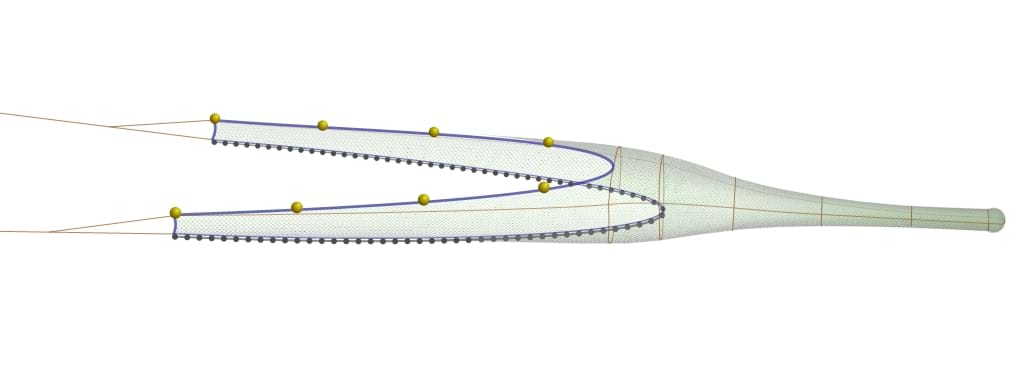Demersal Trawl - Scraper net
Alternative names
-
- scrapper net, scrapper trawl
Summary
A long low, demersal trawl towed on the seabed, with the mouth held open by a pair of otter boards (trawl doors) designed to target fish or shellfish that live on or very close to the seabed. This is the type of trawl favoured by many of the twin rig vessels in North East Scotland.

Environmental impact
Selectivity
Size selection in this gear can often be managed by cod-end mesh size or use of basic selective devices. Species selection is often managed by gear design and or spatial and seasonal management of the fishing operation. There is a lot of criticism of demersal trawls but in general the gear is much lighter on the seabed than many realize. The fisherman has to rig the gear so that it maintains contact with the seabed but does not ‘dig’ in at all as this will stop the vessel and is very likely to damage the gear or even lose the gear on the seabed.
Seabed impact
As with all trawls there will be a certain degree of seabed impact with the trawl doors. When used properly the weight of any trawl door on the seabed will be much reduced compared to its weight on land. In most demersal trawl fisheries the weight of the trawl door on the seabed will be approximately 20-25% of its weight in air. This is due to several factors. One is about an 8 -10% reduction due to the weight of steel and other materials in water. The other major factor is the tension of the gear behind the trawl door and the uplift from the warp towing the trawl door. There will be very little impact on the seabed from the sweeps and bridles or the ground gear of the trawl as this is generally very light gear when in use.
The ground gear on a demersal trawl can range from a light weight grass rope footrope to heavy rock hopper gear that enables the trawl to be towed over hard rough sea beds. Although some of these gears look heavy once they are in the water and the buoyancy (floats) of the net and the tension is on the gear much of this weight is lost and the gear is much lighter on the seabed than expected.
Other information
The scraper trawl or 'scrapper trawl' is similar to the prawn net but has longer wings and the headline height is slightly higher. It has evolved from the prawn net, designed to catch more of the valuable bottom-living species such as monkfish and megrims. It developed as the demand, and market prices, for these bottom living species increased in the early eighties. Originally it was a very low net but over the years it has been developed to have a greater headline height to also target some of the other demersal round fish species that live close to the seabed.
As with the sole net, this often used as a twin-rig trawl. In recent years to meet the demands of the Landing Obligation many skippers have been getting the nets redesigned to have a very low headline height to avoid excessive by-catch of round fish. The sole net, prawn net and scraper net usually have long low wings with a simple vertical wing end that is designed to restrict the headline height. They are often towed in twin and multi rig configurations to cover a wider area of seabed thereby improving catches of the sought after bottom living species.
Documents
-
Assessment of Stress and Mortality of the Prawn During Live Handling from Vessel to Market
-
Discard collection study comparing the SFIA designed nephrops trawl against commercial trawls
-
Economics of Quality at Sea for Nephrops - Key Features
-
Responsible Sourcing Guide - Nephrops
-
Summary report of Gear Trials to Support Ireland’s Submission under Articles 11 & 13 of Reg. 1342/2008 Nephrops Fisheries VIIa & VIIb-k
-
Trials of a Net Grid for the UK Nephrops trawl fisheries
-
The Swimming and Orientation Behaviour of the Norway Lobster, Nephrops norvegicus (L.), in Relation to Trawling
Gear classification
Main target species (UK)
-
- Any demersal species
- Megrims
- Monkfish
- Nephrops
Possible bycatch
-
- Dab
- Dogfish
- Flats
- Gurnard
- Haddock
- Hake
- Immature round fish
- Juveniles of the target species
- Lemon sole
- Ling
- Pollock (Lythe)
- Plaice
- Witch
- Whiting